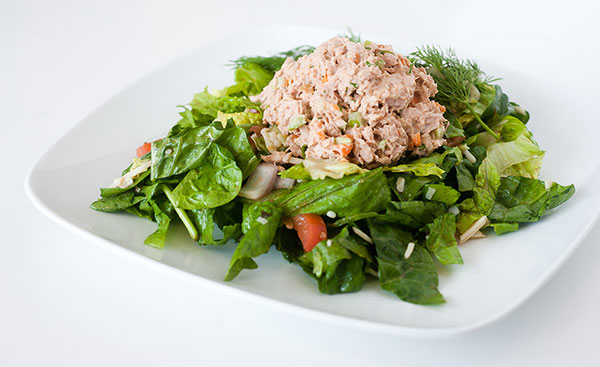Too Hot to Cook? Meals When You Don’t Want to Turn on the Oven

It’s important to keep eating when temperatures outside are hot, even if the last thing you want to do is add more heat inside by turning on the oven or stovetop. Eating and drinking help to keep us hydrated and stay cool.
I asked my amazing team of registered dietitians what they fed their families during the recent record-breaking temperatures when it was too hot to cook. Try their suggestions the next time you want to cook without heat.
All these dishes are low in sodium. Cutting the salt in your diet is one way to beat high blood pressure, kidney disease, and heart disease. Even on a hot day, you only need about 500 milligrams of sodium. The average American diet is between 3,000 and 4,500 milligrams a day. A healthy goal for everyone is 1,500 milligrams a day.
You will notice several hardy salads with good protein sources that are guaranteed to keep you cool and nourished so you have more energy to tolerate the heat.
- Fire and Ice Salad: Combine watermelon with feta or lower-sodium goat cheese, fresh mint, and red onion. Drizzle with balsamic vinegar.
- Hummus, Cucumber and Avocado Wraps
- Mediterranean Salad: Combine zucchini or other summer squash, red bell pepper, and homemade low-sodium salad dressing.
- Niçoise Salad: When it’s cooler in the morning, cook the new potatoes in the microwave, cook the eggs on the stove, and blanch the green beans. Put them all in the refrigerator to chill for the day. Serve on a platter with chilled, canned tuna, and let folks serve themselves.
- Nachos: Only takes five minutes under the broiler, while canned low-sodium refried beans are heated in the microwave. Serve with diced fresh avocado, quick fresh tomato salsa and sour cream.
- Slow Cooker Carnitas or Pulled Pork Sandwiches: Put the meat and a sliced onion in your slow cooker in the morning. Season as desired. Cook on low for 7–8 hours, or on high for 4–5 hours. Meat is tender when you can pull it apart with two forks. Chill in refrigerator or serve warm with taco chips or corn tortillas, which are much lower in sodium than flour tortillas. Top with chopped red onion, fresh chopped cilantro, sour cream, and guacamole. Two pounds of pork makes about 6 servings.
- Spinach Salad with goat cheese and grilled plums
- Tuna Salad with a Twist: Everyone suggested a variation on tuna salad. There is no right or wrong way. Use what’s in the refrigerator. Use up leftovers, substitute salmon for tuna, or leave the tuna out completely and substitute cauliflower, garbanzo beans, or hard-cooked eggs. Try substituting half plain yogurt or sour cream to cut the sodium. Rinsing the canned tuna or canned beans in a colander also will remove a lot of added salt. Other add-ins to the traditional tuna salad were hazelnuts, cold unfrozen peas, quinoa, and edamame. Seasonings included fresh dill, fresh tarragon, fresh parsley, curry powder and onion. Taste as you go and adjust the seasoning accordingly.
- Vietnamese Rice Wraps with chilled greens: Combine Thai basil, cilantro, beansprouts, chilled tofu, and pre-cooked shrimp. Boil some rice vermicelli (it only takes a few minutes). Serve with a low-sodium, sweet chili sauce and skip the salty soy sauce.
Beverage ideas
- Prepare a pitcher of lemon-flavored herb tea (5–7 tea bags) and refrigerate for several hours.
- Add cucumber slices or lemon to water (you will drink more if it tastes good).
- Serve root beer floats or Italian sodas for a treat at the hottest part of the day.
- Make iced coffee and freeze the leftover in cubes to use later in frappe-type drinks.
Find more healthy options at www.nwkidney.org/recipes.
 Contributor Katy G. Wilkens is a registered dietitian and department head at Northwest Kidney Centers. The National Kidney Foundation Council on Renal Nutrition has honored her with its highest awards for excellence in education and for significant contributions in renal nutrition. She has also been awarded the Medal of Excellence in kidney nutrition from the American Association of Kidney Patients.
Contributor Katy G. Wilkens is a registered dietitian and department head at Northwest Kidney Centers. The National Kidney Foundation Council on Renal Nutrition has honored her with its highest awards for excellence in education and for significant contributions in renal nutrition. She has also been awarded the Medal of Excellence in kidney nutrition from the American Association of Kidney Patients.
Eating Well, Living Well classes
Katy Wilkens leads a team of registered dietitians who teach FREE nutrition classes at convenient times and locations around Puget Sound. The Eating Well, Living Well classes teach people how to eat healthier to slow the progress of kidney disease and postpone dialysis. Studies show that working with a registered dietitian can postpone dialysis for as long as two years. Learn more at www.nwkidney.org/classes.
![AgeWise King County [logo]](https://www.agewisekingcounty.org/wp-content/themes/agewisekingcounty/images/logo.png)